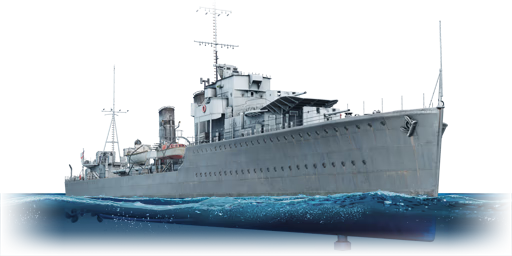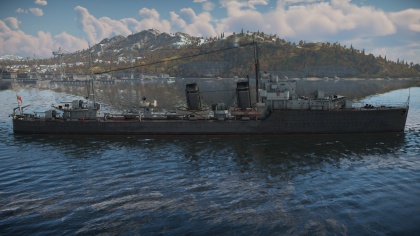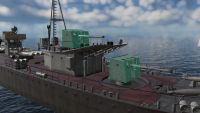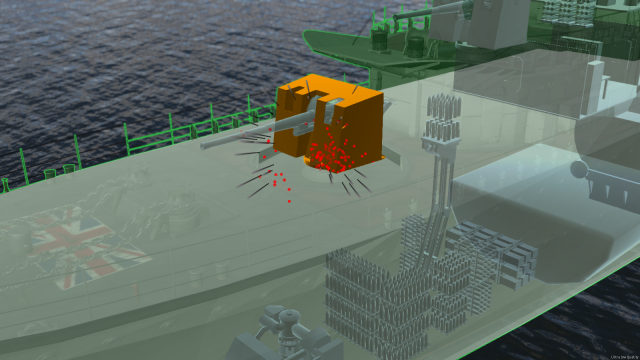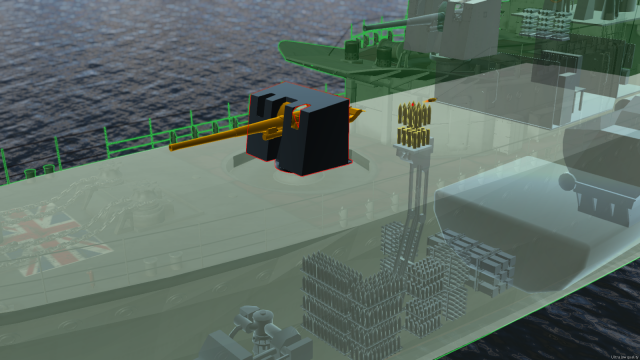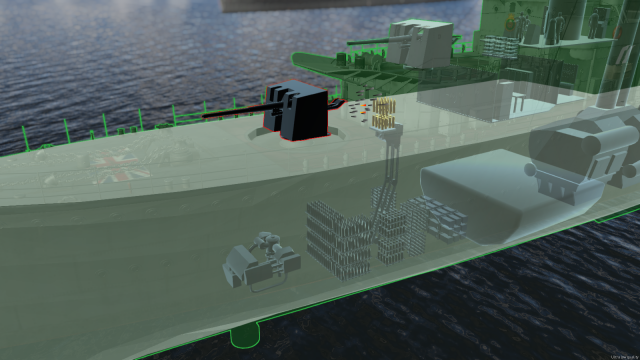Difference between revisions of "HMS Grafton"
m (Tag: Visual edit) |
m (Tag: Visual edit) |
||
| Line 15: | Line 15: | ||
=== Survivability and armour === | === Survivability and armour === | ||
| − | <!-- ''Talk about the vehicle's armour. Note the most well-defended and most vulnerable zones, e.g. the ammo magazine. Evaluate the composition of components and assemblies responsible for movement and manoeuvrability. Evaluate the survivability of the primary and secondary armaments separately. Don't forget to mention the size of the crew, which plays an important role in fleet mechanics. Save tips on preserving survivability for the "Usage in battles" section. If necessary, use a graphical template to show the most well-protected or most vulnerable points in the armour.'' -->[[File:G-class Main armour .png|thumb|'''4.97 mm''' of antifragmentation armour plate on Grafton's main gun.| | + | <!-- ''Talk about the vehicle's armour. Note the most well-defended and most vulnerable zones, e.g. the ammo magazine. Evaluate the composition of components and assemblies responsible for movement and manoeuvrability. Evaluate the survivability of the primary and secondary armaments separately. Don't forget to mention the size of the crew, which plays an important role in fleet mechanics. Save tips on preserving survivability for the "Usage in battles" section. If necessary, use a graphical template to show the most well-protected or most vulnerable points in the armour.'' -->[[File:G-class Main armour .png|thumb|'''4.97 mm''' of antifragmentation armour plate on Grafton's main gun.|200x200px]] |
The crew size is an essential indicator of survivability amongst destroyers. HMS ''Grafton'' does not offer any significative advantage over other Rank I destroyers, with her crew being only of 145. Captains must be prudent in their combat actions to preserve the life of their complement. | The crew size is an essential indicator of survivability amongst destroyers. HMS ''Grafton'' does not offer any significative advantage over other Rank I destroyers, with her crew being only of 145. Captains must be prudent in their combat actions to preserve the life of their complement. | ||
| Line 23: | Line 23: | ||
* '''4.97 mm''' of antifragmentation armour | * '''4.97 mm''' of antifragmentation armour | ||
| − | This antifragmentation armour stops HE shells and low calibre machine guns '''(7.7mm)'''. But it won't be enough to stop heavy machine gun calibre or higher calibres (20mm+), also any SAP shell or HE with base fuze will disable the turret. Thus the only use of the armour is to conceal and to fragment any HE shells; protecting the crew and the gun's breech from the shrapnel while the armour resists the damage. <gallery mode="packed | + | This antifragmentation armour stops HE shells and low calibre machine guns '''(7.7mm)'''. But it won't be enough to stop heavy machine gun calibre or higher calibres (20mm+), also any SAP shell or HE with base fuze will disable the turret. Thus the only use of the armour is to conceal and to fragment any HE shells; protecting the crew and the gun's breech from the shrapnel while the armour resists the damage. <gallery mode="packed"> |
File:G-class turret damage 1.png|Turret state after German HE (Sprgr. Kpf.Z) impact. Armour successfully deters the shell. | File:G-class turret damage 1.png|Turret state after German HE (Sprgr. Kpf.Z) impact. Armour successfully deters the shell. | ||
File:G-class turret damage 2.png|Turret state after German HE with base fuze (L/4.4 Bd.Z) impact; note the ammo rack damage. | File:G-class turret damage 2.png|Turret state after German HE with base fuze (L/4.4 Bd.Z) impact; note the ammo rack damage. | ||
Revision as of 09:30, 16 December 2020
Contents
Description
The G-class, HMS Grafton (H89), 1936 is a rank British destroyer
with a battle rating of (AB), (RB), and (SB). It was introduced in Update 1.83 "Masters of the Sea" as part of the British fleet closed beta test.
HMS Grafton, pennant number H89, part of the G class, is a destroyer built for the Royal Navy during the 1930s. She had a relatively short, diverse and honourable operational history.
It serves as a combat destroyer introduction to British captains. Grafton gives the chance to sense the game style of a combat-worthy destroyer. Unlike the Town class which are escort destroyers, she can stand its ground against similar or even superior enemies; thus providing a useful experience for the yet more powerful destroyers down the research tree.
General info
HMS Grafton performs excellently in the destroyer vs destroyer area, thanks to her 4 x 4.7 inch/45 Mk.XII (120 mm) main guns. Her mobility is also remarkable, but the less appealing aspects are her lacklustre anti-air defences and the yet below-average crew size.
Survivability and armour
The crew size is an essential indicator of survivability amongst destroyers. HMS Grafton does not offer any significative advantage over other Rank I destroyers, with her crew being only of 145. Captains must be prudent in their combat actions to preserve the life of their complement.
The armour present on the HMS is limited to gun shielding and turret protections consisting of:
- 12.7 mm of antifragmentation armour
- 4.97 mm of antifragmentation armour
The HMS Grafton's hull is made of 16 mm of steel while the superstructure is protected by 10 mm of steel.
This armour won't provide significant protection against most of the destroyer's main calibre shells (100 mm +). The hull armour is only practical against 12.7 mm or less. Any HE shell impact to the hull, will cause the total loss of crew in that compartment. Usually, shells with more than 2 kg of explosive mass.
The superstructure can protect against low calibre machine guns but any aircraft with automatic cannons like the Soviet Il-2s or the German Junkers will pierce the superstructure of the ship. Increasing the risk of an ammo rack detonation because of the aircraft's strafing rounds. This packed with the poor anti-air defences is not a good deed for survivability; be observant.
Ammo racks
On the bow section, is present an unsafe spot for the Grafton: The ammo racks. This area is filled with ready ammo racks near both turrets and just beneath it, a big stash of ammunition is located. This ammo storage is unprotected by any fuel tank or armour and is located above the waterline. Enemy ships will often target this zone with AP or HE with base fuze, because of how easy it is to hit it and detonate the main ammo rack.
APCBC shells found on destroyers such as those on the Italian rank I, can cause catastrophic damage to the ammo rack with some precise shooting. The elevator for the ammo can also be damaged during combat, hindering the reload rate of the main guns.
The numerous torpedoes inside the torpedo tubes are actually well protected against HE and shrapnel. It is unlikely they will generate any harm for the Grafton- Only a very well placed SAP or AP shot might detonate them.
Mobility
HMS Grafton offers an increase in mobility to British captains.
The speed is actually on par or superior to other destroyers in the rank. This allows the Grafton to perform bold and dynamic manoeuvres as a light and nimble combat destroyer. This is particularly pleasant in arcade mode, in which the Grafton can achieve a very respectable speed of 75 km/h.
Mobility plays an important role in the playstyle of the Grafton. Because of the poor targeting speed of the main cannons, the H89 will need to often steer to help the turrets get on target. Captains must be clever to fire first using the mobility in their odds. With the torpedoes, something similar happens. The H89 needs to steer quite a lot to allow the release of torpedoes.
Performing evasive manoeuvres against planes or torpedoes shouldn't be much trouble for the agile Grafton. {| class="wikitable" style="text-align:center" ! colspan="4" | Mobility Characteristics |- ! rowspan="2" | Game Mode ! rowspan="2" | Upgrade Status ! colspan="2" | Maximum Speed (km/h) ! rowspan="2" style="display:none;"| Turn Time (s) ! rowspan="2" style="display:none;"| Turn Radius (m) |- ! Forward ! Reverse |- | rowspan="2" | AB | style="display:none;"| Stock | style="display:none;"| ___ | style="display:none;"| ___ | style="display:none;"| | style="display:none;"| |- | Upgraded || || | style="display:none;"| | style="display:none;"| |- | rowspan="2" | RB/SB | style="display:none;"| Stock | style="display:none;"| ___ | style="display:none;"| ___ | style="display:none;"| | style="display:none;"| |- | Upgraded || || | style="display:none;"| | style="display:none;"| |- |}
Armament
Primary armament
H89 is armed with 4x turrets of 4.7 inch/45 Mk.XII (120 mm) guns.
These guns were used widely by destroyers during WWII, and are present in the same numbers in War Thunder. Is worth to familiarize with the ballistics and the damage mechanics. They are remarkably adequate in terms of damage and rate of fire. The gun's explosive mass is excellent. Any small boat will often sink into hull break due to the strong blast force. Is actually possible with a single shot per turret, to dispose of a small patrol boat. Hence 4 patrol boats can be destroyed in quick succession due to the rapid-fire and the powerful explosive mass.
They also hold the ability of dual-purpose guns, this expands the value against not only naval threats but aerial threats. The guns provide really good elevation angles (40°), which are not 90° but achieve the purpose of fighting against enemy aircrafts. It was deemed acceptable during WWII since the intention was to engage an enemy aircraft attacking another member of the fleet. While the destroyers acting as an anti-air screen for the battlefleet during the air raids.
The trouble of the armament is about the mounting itself. The turrets are really slow on the horizontal traverse, only 7.0°/s. This difficult slow traverse is very noticeable if the ship is halted. It affects the ability to quickly retaliate fire to any ship encountered in a new untargeted direction.
Any destroyer with the same level of mobility and with faster turret traverse will have an advantage of over HMS Grafton.
The 4.7 inch/45 Mk.XII (120 mm) can use 4 types of ammunition:
- 4.7 inch HE Mk.VIIA
- 4.7 inch SAP Mk.VA
- 4.7 inch HT-TF Mk.VIIA
- 4.7 inch HT-VT Mk.VIIA
The recommended shell to engage other destroyers is HE Mk.VIIA.
Anti-aircraft armament
The Vickers Mk.V (12.7 mm) turrets are present in the HMS Grafton on a anti-air role.
The 2 turrets of 4 Vickers Mk.V heavy machine guns offer really good damage against any patrol boat. This is notable on other vehicles such as the MGB-61 that uses them as the main armament. Grafton can engage any patrol boat with them, however, the main cannons remain the first choice because of the hull break capacities.
The Vickers mountings are placed one in starboard and one in port. They have really good elevations angles of 75° which generally allow them to overlap their range to fire together against a target. The intended purpose of these guns is to provide an obstacle to enemy aviation. But their use is limited to close ranges, often too close. The Vickers also lack the stopping power of auto-cannons to successfully down all-metal planes. Armoured attackers will also be a significant concern to the heavy machine guns.
The range in which the AI gunners start to open fire is below 2,000m. The player must remember this range since the guns will start to open fire often too late to perform manoeuvres against low-level bombers or torpedo attackers.
Torpedo armament
Torpedo launchers are standard equipment on many ships and boats. Torpedoes are a significant means of defeating an opponent. Evaluate the position of the torpedo launchers, discuss the ammunition available, firing specifics such as dead zones, features of the torpedoes themselves, etc. If there is no torpedo armament, remove this section.
Special armament
Depth charges, mines, rocket launchers and missiles are also effective in skilled hands and can take an off-guard opponent by surprise. Evaluate the ammunition of this type of armament and rate its performance in combat. If there are no special armaments, remove this section.
Usage in battles
Describe the technique of using this ship, the characteristics of her use in a team and tips on strategy. Abstain from writing an entire guide – don't try to provide a single point of view, but give the reader food for thought. Talk about the most dangerous opponents for this vehicle and provide recommendations on fighting them. If necessary, note the specifics of playing with this vehicle in various modes (AB, RB, SB).
Modules
| Tier | Seakeeping | Unsinkability | Firepower | |||
|---|---|---|---|---|---|---|
| I | Dry-Docking | Tool Set | 4.7 inch SAP Mk.VA | 12.7 mm I | ||
| II | Rudder Replacement | Fire Protection System | Smokescreen | 4.7 inch HE-TF Mk.VIIA | 12.7 mm API | Auxiliary Armament Targeting |
| III | Propeller Replacement | Ventilation | Shrapnel Protection | Improved Rangefinder | Primary Armament Targeting | |
| IV | Engine Maintenance | New Pumps | Ammo Wetting | 4.7 inch HE-VT Mk.VIIA | Bomb mortar | Torpedo Mode |
Pros and cons
Pros:
- Powerful main armaments of 4x 120 mm guns, with a great explosive mass of 3 kg
- Useful mobility and adequate turning time; great on Arcade mode
- 8x Torpedoes are useful for area saturation
- Diversity of shells for the main guns (HE, SAP, HE-TF, HE-VT)
- Dual purpose main cannons; can perform as anti-air
- Improved speed and armament when compared with reserve HMS Churchill
Cons:
- Poor crew size; captains couldn't realize how fast it decreases against ships with 300 or 200 crew members
- Absence of auxiliary armament of any sort
- Only 2 turrets with Vickers Mk.V anti-air machine guns; also deficient due to short-range (-2000m)
- Non-existent protection of the ammo ready and main racks; they can be easily detonated
- Reduced numbers of depth charges guns; no guns in the stern of the ship
History
HMS Grafton was laid down in August 1934 as the fifth ship of nine G-class destroyers being built by British dockyards in the interwar years. Almost two years later, in March 1936, the ship was completed and joined the ranks of the Royal Navy.
HMS Grafton spent her early service days as part of the 1st Destroyer Flotilla operating in the Mediterranean. During the Spanish Civil War, HMS Grafton assisted in enforcing the non-intervention policy alongside warships of other nations.
During the outbreak of WW2 in September 1939, HMS Grafton was undergoing refits at Malta, being called back to British waters in the following October. In early 1940, Grafton underwent minor overhaul work before being assigned to escort convoys headed for Norway.
At the same time, the war situation in France was looking desperate with the start of the Siege of Calais. Operation Dynamo, the allied effort of evacuating cut-off troops from Dunkirk, commenced shortly after. HMS Grafton answered the call and assisted with evacuating troops from the 27th, May 1940.
Two days later however, HMS Grafton spotted survivors of the previously sunk destroyer HMS Wakeful and stopped to commence rescue efforts. Stationary, Grafton presented herself as easy prey for any attacker. Soon enough, she found herself in the crosshairs of the German submarine U-62.
Although severely damaged by the torpedo attack, HMS Grafton stayed afloat long enough for her survivors to be rescued by the destroyer HMS Ivanhoe. Realizing the extent of her damage, the decision was made to scuttle HMS Grafton by gunfire from Ivanhoe. After the shelling, HMS Grafton quickly sank to the bottom, marking the end of her service life and contribution to WW2.
- From Devblog
Media
Excellent additions to the article would be video guides, screenshots from the game, and photos.
See also
Shared operational history
Related development (Same class)
Analogues on other nations
- Type 1924 Leopard (Germany)
- Dardo (Italy)
- Clemson (DD-213) (United States)
- Frunze (USRR)
External links
- [Devblog] HMS Grafton (H89): The spirit of self-sacrifice
- The Royal Navy, 1930-2000: innovation and defence, p19-41:, Pugh, Harding, editor, (2004)
- British Destroyers, March, (1967) p.401.
- [1][Wikipedia] HMS Grafton (H89)
| Britain destroyers | |
|---|---|
| Town-class | HMS Churchill · HMS Montgomery |
| V-class | HMS Valhalla · HMS Vega · HMS Verdun |
| G-class | HMS Grafton · ORP Garland |
| Hunt-class | HMS Calpe · HMS Brissenden |
| Tribal-class | HMCS Haida · HMS Eskimo · HMS Mohawk |
| J-class | HMS Jervis |
| K-class | HMS Kelvin |
| N-class | HMAS Nepal |
| Battle-class | HMS Armada · HMS Cadiz · HMAS Tobruk |
| Daring-class | HMS Daring · HMS Diamond · HMS Diana |


